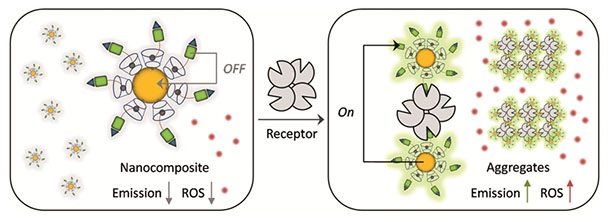来自华东理工大学、中科院上海药物所和英国巴斯大学的研究团队以荧光标记的糖配体与环糊精修饰的金纳米以超分子组装形成的金属纳米复合物,它具有使用两个不同的荧光机制:福斯特共振能量转移(FRET)和金属增强荧光(MEF),并通过配体-受体相互作用实现控制。荧光团至颗粒近端产生FRET猝灭荧光。随后,特异性蛋白受体相互作用导致复合材料的聚集,激活由远端金属颗粒到聚集体间的MEF荧光。聚集还可以启动复合材料的吸光度的红移,从而提高生产活性氧(ROS)来发射红光。该纳米复合物已被证明适用于有针对性的癌细胞成像,还可通过光动力和药物传递性能实现多模态治疗。

报道刊物:Chemical Science (IF=9.0)2016, 7, 4004-4008. DOI:10.1039/C6SC01463A
论文作者:Xi-Le Hu, Yi Zang, Jia Li, Guo-Rong Chen, Tony D. James, Xiao-Peng He, He Tian
Abstract
We have developed a theranostic nanocomposite of metallic nanoparticles that uses two distinct fluorescence mechanisms: Förster Resonance Energy Transfer (FRET) and Metal-Enhanced Fluorescence (MEF) controlled by ligand–receptor interaction. Supramolecular assembly of the fluorophore-labeled glycoligands to cyclodextrin-capped gold nanoparticles produces a nanocomposite with a quenched fluorescence due to FRET from the fluorophore to the proximal particle. Subsequently, interaction with a selective protein receptor leads to an aggregation of the composite, reactivating the fluorescence by MEF from the distal metallic particles to fluorophores encapsulated in the aggregates. The aggregation also causes a red-shift in absorbance of the composite, thereby enhancing the production of reactive oxygen species (ROS) on red-light irradiation. Our nanocomposite has proven suitable for targeted cancer cell imaging as well as multimode therapy using both the photodynamic and drug delivery properties of the composite.
-
2020-11-25
-
2020-01-12
-
2019-12-10
-
2017-06-01
-
2017-04-21
-
2017-04-09
-
2017-01-17
-
2017-01-17
- ▪ 2020国自然生物医工项目(重点、面上项目)
- ▪ 2020国自然生物医工项目(地区、青年项目)
- ▪ 2019国自然生物医工项目(重点、面上项目)
- ▪ 2019国自然生物医工项目(地区、青年项目)
- ▪ 舜纳医工新型全氟丙烷微泡超声造影剂(研发级)发布上市
- ▪ 科研用巨噬细胞清除剂(氯磷酸二钠脂质体Clodronate Liposomes)量产上市
- ▪ 舜纳纳米受邀在“创新绍兴”成果对接会进行《医工交叉研究技术服务和新型纳米医药研发平台》主题交流
- ▪ 小核酸药物引领生物医药变革(核酸药物载体技术)
- ▪ 可注射仿生水凝胶高效修复半月板、软骨等骨关节损伤技术
- ▪ 舜纳纳米功能胶束载药技术——助力上海市重点项目转化应用
- ▪ 新型抗肿瘤生物治疗药物——抗肿瘤核酸疫苗 (舜纳纳米 免疫载体)
- ▪ 肿瘤疫苗增效新思路:皮下注射智能水凝胶技术
- ▪ CAR-T细胞分泌的外泌体具有高效低毒抗肿瘤作用
- ▪ 新型紫杉醇胶束Apealea(paclitaxel micellar)获欧盟批准上市
- ▪ 2018国自然生物医工项目(重大及面上项目)汇总分析




